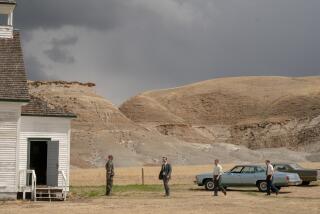Linking Up With ‘Ada’
- Share via
The Laemmle Theaters’ “American Independents” continues at the Sunset 5 on Saturday and Sunday at 10 a.m. with Lynn Hershman Leeson’s ambitious and ultimately captivating “Conceiving Ada.” In the film, a San Francisco computer wizard, Emmy Coer (Francesca Faridany), not only taps into the life of Lord Byron’s brilliant and controversial daughter, Ada (Tilda Swinton), but tries to transmit Ada’s memory and genius into the baby that Emmy is carrying. Leeson is remarkably persuasive in pulling off this cyberspace tale, but it takes awhile for the film to kick in, both in setting up its technological aspects and in weighing down the abrasive, obsessive Emmy in trite conflicts with her well-meaning mother (Karen Black) and neglected lover (J.D. Wolfe). When emphasis shifts to Ada, the film comes fully alive. Too bad Leeson didn’t see that the plight of Ada as a woman ahead of her time carries sufficient feminist charge for the entire film, which is astonishingly resourceful in its use of San Francisco interiors and locales to re-create Ada’s vanished world. (323) 848-3500; repeats May 20 and 21, 11 a.m., at the Monica 4-Plex: (310) 394-9741.
Francesco Manso’s “Testamento,” which opens a regular run Friday at the Music Hall, means to be a sly and sexy comedy with some serious implications but is too talky and slow for its own good. Maria Ceica stars as the daughter of a former servant to the wealthiest citizen of the town of Mindelo who unexpectedly makes her the heir to his fortune. (310) 274-6869.
*
Christine Fugate’s “The Girl Next Door,” an insightful and thoughtful documentary opening Friday for one week at the Nuart, traces the evolution of a likable and pretty Oklahoma divorcee into porn superstar Stacy Valentine. She worries about becoming addicted to cosmetic surgery. And her boyfriend, Julian, a well-known porn actor in his own right, feels that the woman he loves has trouble separating herself from her painstakingly constructed seductress image. Valentine is reflective and intelligent yet perhaps more caught up in her profession than she thinks. (310) 478-6379.
LACMA presents Friday and Saturday at 7:30 p.m. Yasujiro Ozu’s subtle 1953 masterpiece “Tokyo Story,” which tells of an elderly couple (Chishu Ryu, Chieko Higashiyama) who come to the city to visit their adult children, who are not as successful as the parents had thought and are too engaged in the struggle for survival to have time for them. From this situation Ozu evokes unforgettably the fleeting quality of life itself. (323) 857-6010.
*
On Wednesday and May 18, the Silent Movie, 611 N. Fairfax Ave., will screen an early Alfred Hitchcock double feature, “The Ring” (1927) and “The Manxman” (1929), the last of his 10 silents. Both star Carl Brisson, the Danish Maurice Chevalier who was father of late producer Frederick Brisson and father-in-law of Rosalind Russell. Under Hitchcock’s direction, he excelled at playing smiling, hearty innocents.
From the start, Hitchcock was clearly fascinated with exploring the resources of the camera, and this is especially evident in “The Ring,” which has the simplest of triangle plots, involving a naive, rising young boxer (Brisson, who began as a boxer) whose flirtatious wife (Lillian Hall-Davies) incites his jealousy with her attentiveness to the devil-may-care champ of Australia (Ian Hunter). (Throughout this film, which is distinguished by striking montages, Hitchcock makes much of a serpentine slave bracelet presented by the champ to his rival’s wife.)
What sets “The Ring” apart from many superficially similar pictures is Hitchcock’s deep concern for the psychology of his characters--he wrote the story himself, and his wife, Alma Reville, adapted it--and the imaginative ways in which he expresses the torment of the fighter.
Hitchcock was pleased with “The Ring,” considered it innovative and the second “true” Hitchcock film after “The Lodger” but told Francois Truffaut that the only point of interest about “The Manxman” was that it was his last silent. He explained that it was based on a famous, esteemed novel (by Sir Hall Caine) and that he had “to respect that reputation.” “The Manxman” is a very dated story about a poor fisherman (Brisson) on the Isle of Man who leaves home to seek his fortune in order to return prosperous enough to satisfy the father of the pretty young woman (Anny Ondra) he loves and wants to marry. He was raised with a local aristocrat and hereditary judge (Malcolm Keene, one of the stiffest and most colorless of the British leading men of the era), whom he asks to be attentive to the young woman Ondra--who ends up pregnant by the aristocrat, long enamored of her. The point of the film is to strike a blow for truth regardless of consequences, but it’s hard to believe in this seduction.
Hitchcock brings to trite material eloquence and impact and elicits luminous portrayals from Brisson and Ondra, the exquisite Polish wife of champion boxer Max Schmeling. There is a sly Hitchcock touch: the repeated image of a mill wheel grinding away, which audiences could take as an allusion to the familiar ancient Greek maxim: “Though the mills of God grind slowly yet they grind exceedingly small”--but which also suggests the relentlessness of sexual desire. Both films will be accompanied by Bob Mitchell at the organ.(323) 655-2520.
*
Note: The UCLA Film Archives’ “A Joseph Losey Sampler,” which runs through May 25 at Melnitz Hall’s James Bridges Theater, begins Tuesday at 7:30 p.m. with “The Big Night” and “The Prowler,” the two 1951 films Losey made before leaving Hollywood for good in order to escape the blacklist. (310) 206-FILM.
More to Read
Only good movies
Get the Indie Focus newsletter, Mark Olsen's weekly guide to the world of cinema.
You may occasionally receive promotional content from the Los Angeles Times.










